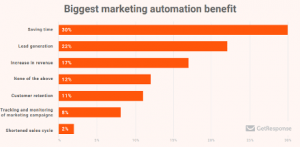Since its earliest days in the 90s, through its coming of age in the 2000s and over the last 10 years, marketing automation has evolved to become an invaluable, if not essential tool, for many organizations. According to a recent study, approximately 56% of companies are using some sort of marketing automation to streamline the marketing process. However, for all its benefits, some companies are still not using the tools available to them to their fullest extent — or at all.
Some companies may mistakenly believe marketing automation is only for Fortune 500 companies and they don’t realize the extraordinary benefits that it can bring to their small or medium-sized organization.
Today I am going to start with a brief overview of some of the benefits marketing automation can bring to the table. The following graph from GetResponse.com highlights just a few of the reasons companies onboard a marketing automation solution.

Source: GetResponse.com
For your marketing team, automation will provide the following benefits, plus many others.
- Increased Efficiency – Automating your marketing messages can help you save time and money. According to Adesra’s “State of Marketing Automation Benchmarks for Success” (2017), 43% of companies list increased productivity as a key goal of marketing automation. Setting up a schedule and components at the beginning of a campaign gives you the benefit of controlling multiple channels at once, utilizing a templated approach to your communications. Creating, managing and tracking the individual components duplicates efforts unnecessarily, whereas an automated plan lets you manage these multiple channels from a single dashboard. For companies who may be operating their marketing with a reduced headcount, this time-saving approach can help you develop a more sophisticated plan in fewer hours. Since automation allows for key points in your marketing funnel to be triggered by customer response, less time is spent collecting and analyzing data.
- Better Insights – When your marketing plan features an automated component, multiple data points are captured and collected into a single database. Whether the response is to a social post, an email campaign or even a print campaign the data is collected at the individual level. This gives you a macro-level insight into which components are yielding the best results, allows you to target which audiences are responding to each channel and see how they are progressing through your marketing funnel. Over time, this increased insight provides invaluable information about your customers and the way they interact with your brand. This provides you with the intelligence you need to update and refine your plan and budget for maximum impact.
- Customer Personalization – One of the superpowers of an automated marketing plan is the ability to increase the personalization of your campaigns easily. This level of personalization begins with creating individual personas for your target audiences and more effectively segmenting your database. Whether you rely primarily on demographics or add psychographics to the mix, these personas help you target messaging to exactly what your audience wants. Once these are defined, a single e-mail send, for instance, can be tailored to each audience with variable data that goes way beyond the simple mail merges of years past. According to Hubspot, personalized calls to action convert 202% better than default calls to action. Imagine your campaign highlighting specific content or products that the individual buyer has shown interest in, without having to create multiple iterations. The individual data collected over the course of your communication with your leads can target those who have responded with relevant information and calls to action that fit with their own preferences. Another degree of personalization is that content can be delivered to each audience member at the time they need to see it, as opposed to only relying on mass communications all at once. This ensures that the information they are getting is timely and tailored to their response rate.
- Brand Consistency – Any marketer knows that consistency is very important in making your brand message stick in the minds of consumers. Utilizing one of the many marketing automation tools available today, your team can develop modular components that can be reviewed and edited in a single sitting. Once refined, these components become the building blocks for your message. Since these components were created and approved together, catching mistakes or creating a consistent message becomes a one-time task instead of something that has to be reviewed at each touchpoint. This allows you the opportunity to get a bigger picture of what you are saying and manage the incremental shifts that often happen over time. Another consistency gained by marketing automation is the consistency of delivery. Too often in marketing, the customer journey is left out of the conversation in the rush to get messaging out. The planning process of setting up an automated marketing campaign gives you the opportunity to really think about how your customer receives and reacts to the information you send. You can easily see (and be prepared for) holes in your plan, or periods of over-communication. Setting triggers that create regularity in your campaign makes sure you stay top of mind without becoming an annoyance.
- Better Lead Conversion – The power of marketing automation really becomes visible when it’s connected to your sales cycle. Many marketing automation systems connect with the leading CRMs or have a CRM component of their own. As target audiences respond they become leads with a trackable history, giving sales teams much better visibility into that lead’s preferences and needs. Like marketing sends, sales communications can be automated to ensure that follow-ups and new communications happen in a timely efficient manner. This feature helps your sales force manage their leads without drowning in data. It also prevents them from having to start the relationship “cold” as they are able to see what that potential customer has gravitated towards and understand where they are in the decision-making process. This, in turn, can lead to reducing the timeline of the sales cycle – which is better not only for the end-user but also for your bottom line.
These are just five of the many benefits of marketing automation. Over my next several blogs I will highlight aspects of marketing automation from its benefits, to how it works, to who should really be using these tools. We’ll also look at how to use the information gleaned from the powerful database you will be creating. If you have any questions or would like to schedule a call to see how marketing automation can be used to streamline your next campaign, don’t hesitate to contact our team.


